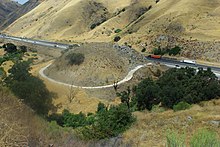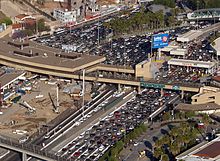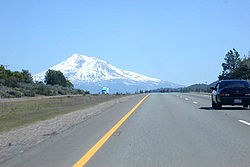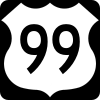Interstate 5
| |
|---|---|
| |
| North end | |
| Location | |
| Country | United States |
| States | California, Oregon, Washington |
| Highway system | |
Interstate 5 (I-5) is the main north–south Interstate Highway on the West Coast of the United States, running largely parallel to the Pacific Coast of the contiguous U.S. from Mexico to Canada. It travels through the states of California, Oregon, and Washington, serving several large cities on the West Coast, including San Diego, Los Angeles, Sacramento, Portland, and Seattle. It is the only continuous Interstate highway to touch both the Mexican and Canadian borders. Upon crossing the Mexican border at its southern terminus, the highway continues to Tijuana, Baja California, as Mexican Federal Highway 1 (Fed. 1). Upon crossing the Canadian border at its northern terminus, it continues to Vancouver as British Columbia Highway 99 (BC 99).
I-5 was originally created in 1956 as part of the Interstate Highway System, but it was predated by several auto trails and highways built in the early 20th century. The Pacific Highway was built in the 1910s and 1920s by the states of California, Oregon, and Washington, and was later incorporated into U.S. Route 99 (US 99) in 1926. I-5 largely follows the route of US 99, with the exception of portions south of Los Angeles and in the Central Valley of California. The freeway was built in segments between 1956 and 1978, including expressway sections of US 99 that were built earlier to bypass various towns along the route. US 99 was removed in 1972.
Route description
| mi[1] | km
| |
|---|---|---|
| CA | 796.53 | 1,281.89 |
| OR | 308.14 | 495.90 |
| WA | 276.62 | 445.18 |
| Total | 1,381.29 | 2,222.97 |
I-5 is a major
California
The southern terminus of I-5 is at the
I-5 bisects the
At the
The freeway then traverses the narrow Grapevine Canyon and descends for 12 miles (19 km) into the San Joaquin Valley.[10] At Wheeler Ridge near the south end of the valley, State Route 99 splits from the freeway to serve Bakersfield and other major cities in the Central Valley, while I-5 stays to the west. Now named the West Side Freeway,[4] I-5 travels northwest along the edge of the Central Valley through farmland and avoids populated areas. The freeway is connected to several of the valley's main cities, including Fresno, Merced, and Modesto, by other highways.[5]
Near
The freeway continues north along the western edge of the
Oregon
I-5 enters Oregon near Siskiyou Summit, which sits at 4,310 feet (1,310 m) and is the highest point on the highway.[11][12] From the summit, I-5 descends by 2,300 feet (700 m) over 6 miles (9.7 km) at a 6 percent grade to reach the Rogue Valley.[13] The freeway passes through Ashland and Medford, running parallel to Oregon Route 99, and turns west to follow the Rogue River to Grants Pass, where it intersects US 199. I-5 then turns north and crosses a series of passes in the Klamath Mountains to reach the Umpqua Valley, where it follows the South Umpqua River to Roseburg.[5][14]
The highway enters the
From Salem, I-5 turns northeast and passes
I-5 and I-405 form a complete loop around
Washington
The highway enters Vancouver at the north end of the Interstate Bridge and immediately intersects Washington State Route 14 near the Fort Vancouver National Historic Site. The freeway passes near downtown Vancouver and continues north through the city's suburbs before being rejoined by I-205 at Salmon Creek. I-5 travels north along the Columbia River to Kelso and Longview, where it switches to following the Cowlitz River between the Willapa Hills and Cascade foothills. The freeway then turns northwest to traverse a prairie and the adjacent cities of Chehalis and Centralia while concurrent with US 12.[5][17]
I-5 continues north to a junction with US 101 in Tumwater, near Olympia and the state capitol campus. The freeway skirts the southeast side of downtown Olympia and turns east to cross Joint Base Lewis–McChord (formerly Fort Lewis and McChord Air Force Base). I-5 then turns north to enter Tacoma but bends east to intersect I-705, a short spur into Downtown Tacoma. The freeway turns north again after leaving Tacoma and its nearby seaport near Fife to traverse the suburbs of South King County. I-5 intersects its eastern bypass of Seattle, I-405, in Tukwila near Seattle–Tacoma International Airport.[17]
The freeway generally follows the
I-5 continues through the northern suburbs of Seattle and turns northeasterly in Lynnwood, where it is rejoined by I-405, which serves the Eastside region. The freeway travels north through Everett, skirting the city's downtown and intersecting US 2, and leaves the Seattle metropolitan area for the rural Skagit Valley. I-5 descends into the valley and travels through Mount Vernon and Burlington before climbing into the Chuckanut Mountains, where it turns west towards Bellingham Bay (part of the Salish Sea). The freeway travels around downtown Bellingham and turns northwest to continue across the rural Fraser Lowland. I-5 terminates at the Peace Arch Border Crossing on the Canadian border, adjacent to the eponymous monument, in Blaine. The highway becomes British Columbia Highway 99, which continues northwest to Vancouver.[17]
History

An extensive section of this highway (over 600 mi (970 km)), from approximately Stockton, California, to Portland, Oregon, follows the track of the Siskiyou Trail.[20] This trail was based on an older network of Native American footpaths connecting the Pacific Northwest with California's Central Valley. By the 1820s, trappers from the Hudson's Bay Company were the first non-Native Americans to use the route of today's I-5 to move between today's Washington state and California. During the second half of the 19th century, mule trains, stagecoaches, and the Central Pacific railroad also followed the route of the Siskiyou Trail.[20] By the early 20th century, pioneering automobile roads were built along the path of the Siskiyou Trail, notably the Pacific Highway. The Pacific Highway ran from British Columbia to San Diego, California, and was the immediate predecessor of much of US 99. The route of US 99 was in turn used as a basis for much of the route of today's I-5.
A major deviation from the old US 99 route is the Westside Freeway portion of I-5 in California's Central Valley. To provide a faster and more direct north–south route through the state, the decision was made to build a new freeway to the west and bypass Fresno, Bakersfield, and the rest of population centers in the area instead of upgrading the existing highway (which was re-designated as part of SR 99).[21] This re-route through California's Central Valley was the last section of I-5 to be constructed, with the final segment dedicated and opened to traffic near Stockton, California, on October 12, 1979. Representatives from both Canada and Mexico attended the dedication to commemorate the first contiguous freeway connecting the North American countries.[22][23] It cost an estimated $2.3 billion in 1979 dollars (equivalent to $7.79 billion in 2023 dollars)[24] to construct all of I-5.[25]
This direct route also bypasses San Francisco and the rest of the San Francisco Bay Area. Original plans called for a loop Interstate with a directional suffix, I-5W.[21] This route now roughly corresponds to I-580 from I-5 south of Tracy to Oakland, I-80 from Oakland to Vacaville, and I-505 from Vacaville to I-5 near Dunnigan. I-5W and most of the other Interstates around the country with directional suffixes were eventually renumbered or eliminated. Nevertheless, San Francisco is still listed as a control city on northbound I-5 between SR 99 and I-580.
By the early 21st century, sections of I-5 had deteriorated due to a maintenance backlog as well as high traffic volumes. Several bridges in Oregon were reconstructed or repaired to accommodate use by heavy freight vehicles.[2]
On May 23, 2013, a bridge span collapsed over the Skagit River in Mount Vernon, Washington, sending two cars into the water and requiring traffic in both directions to bypass the crossing.[26] The Washington State Department of Transportation used a temporary structure to restore access across the river while a permanent bridge replacement was built. That process was completed September 15, 2013.[27]
On December 18, 2017, an Amtrak train derailed on an overpass crossing I-5 near Tacoma, Washington, and blocked several lanes of traffic.[28]
The I-5 corridor forms part of the West Coast Electric Highway, a partnership between the states of California, Oregon, and Washington to build and maintain a network of charging stations for electric vehicles. The pact was formed in 2009 and the first charging stations—spaced 25 to 50 miles (40 to 80 km) apart—opened in 2011.[29] In 2019, the three states also broke ground on a similar charging network for electric trucks along I-5 called the West Coast Clean Transit Corridor Initiative.[30] The program is a collaboration of nine utilities and two agencies representing municipal utilities, and aims to enable electric freight and delivery trucks to operate along the entire West Coast corridor.[31]
Junction list



- California[32]
 Fed. 1 at the Mexican border in San Diego
Fed. 1 at the Mexican border in San Diego I-805 in San Diego
I-805 in San Diego SR 905 in San Diego
SR 905 in San Diego SR 15in San Diego
SR 15in San Diego I-8 in San Diego
I-8 in San Diego I-805 in San Diego
I-805 in San Diego I-405 in Irvine
I-405 in Irvine I-605 on the Downey–Santa Fe Springs line
I-605 on the Downey–Santa Fe Springs line I-710 in Commerce
I-710 in Commerce US 101 in Los Angeles
US 101 in Los Angeles I-10 in Los Angeles. The highways travel concurrently through the Boyle Heights neighborhood.
I-10 in Los Angeles. The highways travel concurrently through the Boyle Heights neighborhood. I-405 in Los Angeles
I-405 in Los Angeles I-210in Los Angeles
I-210in Los Angeles SR 14 in Los Angeles
SR 14 in Los Angeles SR 99 in Wheeler Ridge
SR 99 in Wheeler Ridge I-580 southwest of Vernalis
I-580 southwest of Vernalis I-205 south-southwest of Lathrop
I-205 south-southwest of Lathrop
 I-305 / US 50 in Sacramento
I-305 / US 50 in Sacramento I-80 in Sacramento
I-80 in Sacramento I-505 south-southeast of Dunnigan
I-505 south-southeast of Dunnigan US 97 in Weed
US 97 in Weed- Oregon[14]
 US 199 east of Grants Pass
US 199 east of Grants Pass I-105 on the Eugene–Springfieldcity line
I-105 on the Eugene–Springfieldcity line US 20 in Albany
US 20 in Albany I-205 in Tualatin
I-205 in Tualatin US 26 in Portland
US 26 in Portland I-405 in Portland
I-405 in Portland
 I-84 / US 30 in Portland. I-5/US 30 travels concurrently through Portland.
I-84 / US 30 in Portland. I-5/US 30 travels concurrently through Portland.
 I-405 / US 30 in Portland
I-405 / US 30 in Portland- Washington[32]
 I-205 on the Salmon Creek–Mount Vista CDP line
I-205 on the Salmon Creek–Mount Vista CDP line US 12 south-southeast of Napavine. The highways travel concurrently to Grand Mound.
US 12 south-southeast of Napavine. The highways travel concurrently to Grand Mound. US 101 in Tumwater
US 101 in Tumwater I-705 in Tacoma
I-705 in Tacoma I-405 in Tukwila
I-405 in Tukwila I-90 in Seattle
I-90 in Seattle SR 520 in Seattle
SR 520 in Seattle I-405 in Lynnwood
I-405 in Lynnwood US 2 in Everett
US 2 in Everett Hwy 99 at the Canada–US border in Blaine
Hwy 99 at the Canada–US border in Blaine
Auxiliary routes
- San Diego, California—I-805
- Los Angeles, California—I-105 (not directly connected)
- Los Angeles and Orange County, California—I-405
- Los Angeles and Orange County, California—I-605
- Tracy, California—I-205
- I-305(unsigned)
- Zamora, California—I-505
- Eugene, Oregon—I-105
- Portland, Oregon—I-405
- Portland, Oregon, and Vancouver, Washington—I-205
- Tacoma, Washington—I-705
- Seattle, Washington—I-405
I-5 will have a complete set of auxiliary routes (i.e. 105, 205, 305, 405, 505, 605, 705, 805, 905), with the completion of
are the only two Interstates to have complete sets of auxiliary routes.Several routes, including
References
- ^ a b Staff (December 31, 2013). "Table 1: Main Routes of the Dwight D. Eisenhower National System Of Interstate and Defense Highways as of December 31, 2013". Route Log and Finder List. Federal Highway Administration. Retrieved March 17, 2014.
- ^ a b Weikel, Dan (July 5, 2004). "The Road More Heavily Traveled". Los Angeles Times. Retrieved January 1, 2023.
- ^ Sweeney, Don (November 25, 2018). "5 things to know about massive San Ysidro border checkpoint closed by caravan protest". The Sacramento Bee. Retrieved December 13, 2021.
- ^ a b c d Caltrans Office of Highway System Information and Performance (January 2021). "2020 Named Freeways, Highways, Structures and Other Appurtenances in California" (PDF). California Department of Transportation. pp. 8–15. Retrieved December 16, 2021.
- ^ a b c d e f g h i j k Google (December 15, 2021). "Overview of Interstate 5" (Map). Google Maps. Google. Retrieved December 15, 2021.
- ^ Masters, Nathan (April 21, 2016). "How the 5 Freeway Made Orange County Suburban". KCET. Retrieved December 15, 2021.
- ^ Edgar, Deirdre (September 19, 2012). "Southern California freeways are a number, not a name". Los Angeles Times. Retrieved December 15, 2021.
- ^ Masters, Nathan (November 10, 2015). "The 5, the 101, the 405: Why Southern Californians Love Saying 'the' Before Freeway Numbers". KCET. Retrieved December 15, 2021.
- ^ Newspapers.com.
- ^ Rasmussen, Cecilia (March 8, 1993). "L.A. Scene: The City Then and Now". Los Angeles Times. p. B3. Retrieved December 15, 2021 – via Newspapers.com.
- ^ LaLande, Jeff (March 17, 2018). "Siskiyou Pass". The Oregon Encyclopedia. Retrieved December 16, 2021.
- ^ Fattig, Paul (October 30, 2012). "ODOT plans to use rock salt for I-5 ice melt". Mail Tribune. Archived from the original on August 10, 2020. Retrieved December 16, 2021.
- ^ "Respect the Siskiyou Pass" (PDF). Oregon Department of Transportation. September 2005. Retrieved December 17, 2021.
- ^ a b c d e Oregon 2019–2021 Official State Map (PDF) (Map). Oregon Department of Transportation. April 2019. Portland and Vicinity inset. Retrieved December 17, 2021.
{{cite map}}: External link in|inset= - ^ Brown, K. Williams (July 10, 2011). "The beauty of halfwayism". Statesman Journal. p. 5D. Retrieved December 16, 2021 – via Newspapers.com.
- ^ Macuk, Anthony (September 19, 2021). "Keeping the Interstate 5 Bridge up and running". The Columbian. Retrieved December 17, 2021.
- ^ a b c d Washington State Department of Transportation (2014). Washington State Highways, 2014–2015 (PDF) (Map). 1:842,000. Olympia: Washington State Department of Transportation. Retrieved December 17, 2021.
- ^ Dorpat, Paul (May 5, 2012). "Clearing the path for Seattle's I-5 ditch, 1961". The Seattle Times. Retrieved December 17, 2021.
- ^ Giordano, Lizz (July 22, 2019). "A driver can dream: Can I-5 express lanes be more nimble?". The Everett Herald. Retrieved December 17, 2021.
- ^ a b "Museum of the Siskiyou Trail". Museumsiskiyoutrail.org. Archived from the original on April 15, 2012. Retrieved November 27, 2011.
- ^ a b "Routes 1-8". California Highways. Retrieved September 19, 2009.[unreliable source]
- ^ Staff. "Timeline of Notable Events of the Interstate Highway System in California". California Department of Transportation. Retrieved March 2, 2014.
- ^ Engellenner, Jon (October 13, 1979). "1,000 See I-5 Opened From Border To Border". The Sacramento Bee. pp. A1, A12. Retrieved December 17, 2021 – via Newspapers.com.
- Gross Domestic Product deflatorfigures follow the MeasuringWorth series.
- ^ "Interstate 5 Finished, End Of Traffic Lights". Napa Register. United Press International. October 12, 1979. p. 3. Retrieved December 17, 2021 – via Newspapers.com.
- ^ Valdes, Manuel (May 24, 2013). "'Horrified' trucker watches I-5 bridge collapse behind him". Seattle: KOMO-TV. Archived from the original on June 8, 2013. Retrieved May 24, 2013.
Officials warned it could be weeks before things returned to normal along the heavily travelled corridor.
- ^ Staff. "I-5–Skagit River Bridge Replacement". Washington State Department of Transportation. Archived from the original on December 3, 2013. Retrieved November 29, 2013.
- ^ Lam, Katherine (December 18, 2017). "Amtrak train derails in Washington state onto Interstate 5; at least 6 dead". Fox News. Retrieved December 18, 2017.
- ^ Voelcker, John (January 9, 2015). "West Coast Electric Highway Serves Thousands Of Electric-Car Drivers". Yahoo News. Retrieved September 19, 2022.
- ^ Carpenter, Susan (May 24, 2019). "Truckers Can Expect an Electrified West Coast Corridor". Trucks.com. Retrieved September 19, 2022.
- ^ "Daimler Trucks North America, Portland General Electric open first-of-its-kind heavy-duty electric truck charging site" (Press release). Daimler Trucks North America. April 21, 2021. Retrieved September 19, 2022 – via Associated Press.
- ^ ISBN 978-0-528-00771-2.
External links
 Geographic data related to Interstate 5 at OpenStreetMap
Geographic data related to Interstate 5 at OpenStreetMap - Interstate 5 at the Interstate Guide





